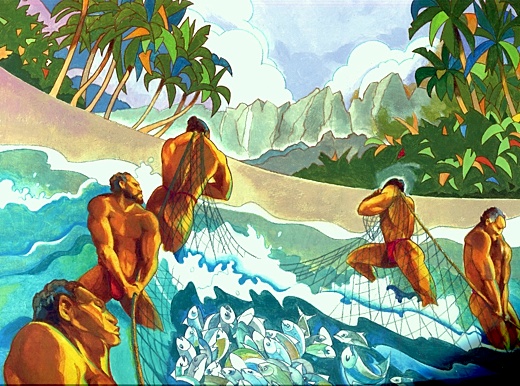SUBHEAD: National Marine Sanctuary Regulations under review do not adequately describe subsistance fishing as practiced in Hawaii.
By Lynn McNutt on 6 February 2013 for Island Breath -
(http://islandbreath.blogspot.com/2013/02/hawaii-fishery-management.html)

Image above: Image above: Detail of conference poster celebrating the gathering of the net created by Oliver Kinney. From (http://islandbreath.blogspot.com/2010/11/aha-moku-gathering.html).
The current definitions of traditional and subsistence fisheries contained in the National Marine Sanctuary Regulations (under review), do not adequately describe fisheries as practiced in Hawaii, and actually exclude many of the most important cultural and local economic benefits.
While giving lip serve to the traditional and subsistence categories, the definitions put forward for fisheries only include commercial and recreational categories, unless specifically noted elsewhere. In reading the proposed revisions for this document, I could only find traditional and/or subsistence fishing being acknowledged in the Thunder Bay, MN, Olympic Coast, WA and American Samoan Sanctuaries.
All marine sanctuaries and/or monuments in Hawaii Must include the categories of traditional and subsistence fishing, and not as a subcategory under the definition for either commercial or recreational fisheries, since the activities in Hawaii are neither commercial nor recreational. As part of another regulatory document, WESPAC included a definition of "customary exchange" to cover non-market (commercial) fisheries with local cultural and economic benefits. While I don't like the term "customary exchange" as a replacement for traditional or subsistence fishing, the description of the activities and the local benefits are well described:
"Define customary exchange as the non-market exchange of marine resources between fishermen and community residents, and the residents’ families and friends, for goods, services, and/or social support, for cultural, social, or religious reasons, and may include cost recovery through monetary reimbursements and other means for actual trip expenses (e.g., ice, bait, food, or fuel) that may be necessary to participate in fisheries in the western Pacific."In writing this new draft of the Sanctuary Management Plan I strongly urge DLNR and NOAA to include true and honest working definitions for traditional and subsistence fishing, recognize these as activities that were in place before the Sanctuary was formed, protect these activities for the people of Hawaii nei in all Sanctuary documents (including the National Marine Sanctuary Regulations), and include these human, cultural and economic aspects in any discussion of 'ecosystem management', as defined below.
The following are definitions of taken from Burroughs (2011, Island Press) in a book entitled "Coastal Governance". I include definitions of "ecosystem governance', "ecosystem-based management" and "ecosystem-based fisheries management". This publication is a textbook used to teach about ecosystem management and coastal governance at the University of Hawaii. In the past, the National Marine Humpback Whale Sanctuary representatives have expressed that they would like to do ecosystem management for Hawaiian Sanctuary waters. However, when describing the approach, it seems to fall more closely within the definition of ecosystem-based fisheries management, not true ecosystem-based management, which includes people, societal mores, and economics.
I urge DLNR to decide if the approach discussed for Hawaii is truly one of ecosystem-based management, or just ecosystem-based fisheries management, In other words, is the approach being proposed truly ecosystem-based management? I do not recommend that DLNR or NOAA follow the ecosystem-based fisheries model. If DLNR and NOAA intend to engage in fisheries management, then, please stop calling the approach ecosystem-based management. They are not the same thing.
Ecosystem Governance: Recognizes the interrelationships among natural (biological, chemical, geological, physical) systems and related social systems and seeks to shape human behavior so that both are sustained using both governmental (law, regulations) and nongovernmental (markets, voluntary organizations, social mores, information) means.See also:
Ecosystem-based Management: Structuring societal behavior in ocean and coastal systems so that humans promote ecosystem health and resilience while allowing sustainable uses of goods and services.
Ecosystem-based fisheries management: Promotion of ecosystem health and resilience rather than single-species management when considering harvest, habitat, predators, and prey of the target species in addition to other interactions.
Ea O Ka Aina: Net Fishing Restrictions 1/24/13
Ea O Ka Aina: Navy Licenseto Kill 10/9/12
Ea O Ka Aina: Feds Threaten Hawaii Sovereignty 1/31/12
No comments :
Post a Comment